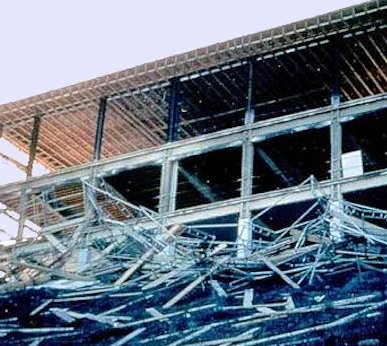Basic Guidelines
Guidelines for Scaffold Erection
What is the most serious visible sign that a scaffold was not erected properly? The photo to the right will give you a clue. That's right: collapse. It's vitally important to make sure that everyone who is involved in the scaffold erection and use is properly trained, and a scaffold erection process has been developed. Let's take a look at the key best practices associated with scaffold erection and use.
Erectors and dismantlers are workers whose principal activity involves assembling and disassembling scaffolding before other work can begin, and after that work, or a portion of it, has been completed.
Training and Competent Person Requirements.
OSHA requires employers to provide training by a competent person to each employee who is involved in erecting and/or disassembling a scaffold. A competent person is defined as one who:
- Is capable of identifying existing and predictable hazards.
- Has authorization to take prompt corrective measures to eliminate such hazards.
Requirements for Designing and Constructing Scaffolds
Scaffolds must be designed by a qualified person and be constructed and loaded in accordance with that design. A qualified person must do adequate preplanning to assure the safe erection and use of the scaffold. Preplanning includes:
- Determining the type of scaffold necessary for the job.
- Determining the maximum load for the scaffold.
- Assuring a good foundation.
- Avoiding electrical hazards.
Knowledge Check Choose the best answer for the question.
1-1. What is the most serious visible sign that a scaffold was not erected properly?
You forgot to answer the question!

